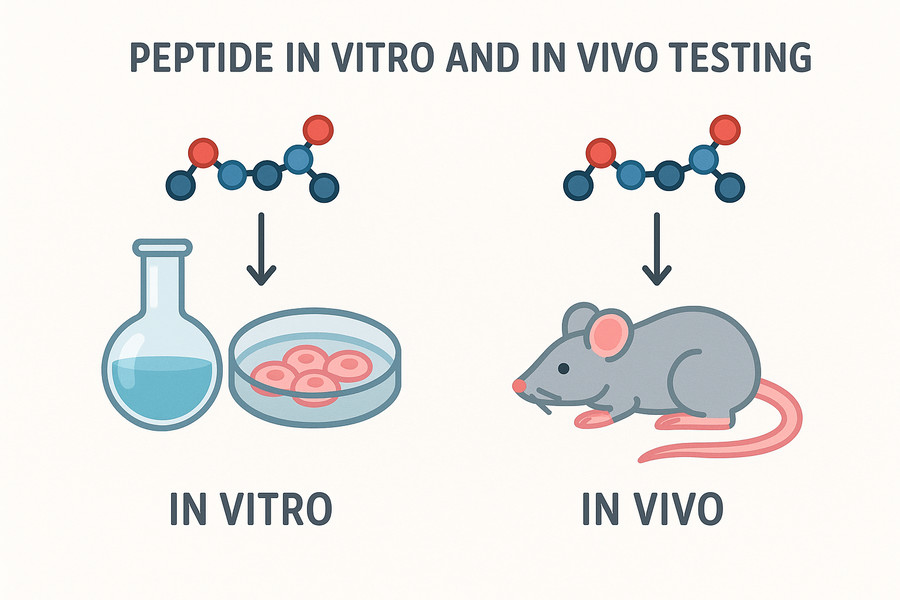BOC Sciences has an advanced platform for peptide research, preparation, and evaluation, capable of providing comprehensive testing services for peptide raw materials, peptide microspheres, peptide nanoparticles, and peptide formulations. These services cover both cellular and animal-level testing. In vitro testing is supported by a high-standard cell platform, enabling efficacy validation and safety analysis for various functions such as anti-aging, whitening, anti-inflammatory, and antibacterial evaluations. For in vivo testing, we leverage our expertise in animal model development to conduct systematic studies on the pharmacodynamics, toxicology, skin permeability, and tissue distribution of peptides. Our platform is fully equipped, with standardized data output and highly flexible customization capabilities, meeting the research and regulatory needs of clients from industries such as medical aesthetics, cosmetics, and biomedicine at different stages of development.

Many functional peptides (such as anti-wrinkle, whitening, and repair peptides) are difficult to evaluate accurately using traditional cell models. BOC Sciences provides various cell models (e.g., human dermal fibroblasts, keratinocytes, melanocytes) and standardized efficacy evaluation metrics, enabling quantitative verification of peptide functions.
The behavior of peptide microspheres, nanoparticles, and other sustained-release carriers in cell models is complex and difficult to characterize using conventional methods. We use techniques like fluorescence tracking, dynamic particle size monitoring, and confocal microscopy to systematically study the release and cellular uptake mechanisms of these systems in vitro.
The permeability of peptide formulations through the skin and their distribution within the body directly impact their efficacy. BOC Sciences has established skin permeability models and small animal imaging technology platforms, allowing for dynamic analysis of peptide distribution in skin and targeted tissues.
Animal model construction for skin aging, whitening, inflammation, and other areas is challenging. BOC Sciences has an experienced animal research team skilled in developing models for photoaging, melanin deposition, wound healing, and more, meeting the preclinical efficacy validation requirements.
Different types of peptides and their carrier systems may cause cytotoxicity or skin irritation. We offer multidimensional safety evaluations, including acute toxicity testing, apoptosis analysis, and skin sensitization assays, ensuring that products meet regulatory or market compliance standards.
Many clients lack a systematic approach during the experimental design phase, making it difficult to convert data into submission materials. BOC Sciences has an interdisciplinary R&D team to assist clients from project initiation and design through experiment execution and data archiving, ensuring results are scientific, compliant, and suitable for filing or registration.
BOC Sciences possesses an advanced cell testing platform focused on evaluating peptide products' efficacy and safety at the cellular level, supporting comprehensive testing from basic mechanism studies to data required for product registration. With a mature testing system, we can accurately assess peptide functions like anti-aging, whitening, moisturizing, anti-inflammatory, repair, and antioxidant effects. Additionally, we are equipped with a professional research team and automated analysis equipment, capable of high-throughput screening, imaging analysis, biomarker detection, and more. We can customize experimental plans to meet clients' needs and provide standardized, traceable, and registration-ready data reports. These services are widely applied in the development of peptide products in the medical aesthetics, cosmetics, and biopharmaceutical industries.
With extensive experience in working with mice, rats, and other experimental animals, we can develop various animal models that meet application-specific needs, including skin aging, melanin deposition, wound healing, inflammation response, and tissue regeneration. These models are particularly suited for peptide function verification and mechanism research in medical aesthetics and biopharmaceutical fields. We have systematic procedures for experimental design, dose assessment, administration routes (e.g., subcutaneous injection, topical application, oral administration), sample collection, and tissue analysis, supporting pharmacokinetics (PK), pharmacodynamics (PD), toxicology, and skin permeability studies. This ensures that our results are highly scientific, reproducible, and suitable for regulatory submission, helping clients efficiently advance peptide products through preclinical development.
BOC Sciences boasts a comprehensive cell and animal experimental infrastructure, establishing a multi-dimensional analytical system ranging from molecular to tissue, organ, and whole physiological systems. The cell platform includes keratinocytes, human dermal fibroblasts, melanocytes, skin microbiome models, and more, supported by precise instruments such as flow cytometers, confocal microscopes, and quantitative PCR. The animal platform is equipped with AAALAC-certified SPF-grade animal housing and supports the establishment of various skin models and pharmacological evaluations. It is further complemented by a professional team for animal behavior monitoring and tissue pathology analysis. With the synergistic operation of these two platforms, BOC Sciences provides comprehensive in vitro and in vivo evaluation pathways for peptide products.
Peptides, as highly active functional ingredients, are widely used in medical aesthetics and cosmetics due to their excellent biocompatibility, targeting abilities, and diverse biological functions. Whether raw peptides or peptide formulations based on nanoparticle, microsphere, or gel delivery systems, these can achieve superior permeability, stability, and prolonged efficacy. BOC Sciences is committed to in vitro and in vivo testing services for peptide products, evaluating anti-aging, whitening, repair, anti-inflammatory, and other functional effects using skin-related cell models and animal models. This provides robust data support and R&D guarantees for peptide-based skincare products, injectable products, and topical formulations, facilitating the progression of peptides from R&D to clinical and consumer markets.

The lab test for peptides typically involves techniques such as High-Performance Liquid Chromatography (HPLC) to assess purity and identity, Mass Spectrometry (MS) for molecular weight determination, and UV-Vis spectrophotometry for concentration measurement. These tests help confirm the peptide's structure, composition, and quality by evaluating factors such as molecular integrity, purity, and the presence of impurities.
The identification test for peptides often includes mass spectrometry (MS) and amino acid analysis. Mass spectrometry helps determine the molecular weight and sequence of the peptide, confirming its identity. Additionally, Edman degradation or liquid chromatography-tandem mass spectrometry (LC-MS/MS) can be used to sequence peptides and verify their structure, offering precise identification by comparing it with known peptide databases.
Yes, drug testing for peptides is possible using methods like liquid chromatography-mass spectrometry (LC-MS/MS), which can detect specific peptide sequences in biological samples such as blood or urine. Peptides used in performance enhancement or illicit drug use can be identified, quantitated, and monitored for any abnormal levels, enabling their detection during anti-doping tests or clinical drug screenings.